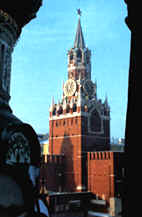|
|
On the side of Red Square, along Kremlin wall, is Kremlin necropolis, sort of revolutionary pantheon, where many well-known Communist figures were buried. Among those buried here are victims of revolutionary fighting in Moscow, heroes of the civil war, politicians, public figures, writers and military commanders of the Soviet period of Russian history.
The first common graves appeared along Kremlin wall between Nikolsky (St. Nicolas) and Troitsky (Trinity) Gates, by order of Moscow Military-Revolutionary Committee. It was decided that the participants in the seven-day revolutionary fighting in Moscow, in November 1917, should be buried there. All in all, 240 people were buried there from November 10 to November 17. To date, over 300 people are buried in “Red Graveyard”, as Vladimir Mayakovsky called the place.
Later, Y. Sverdlov (1919), M. Frunze (1925) and F. Dzerzhinsky (1926) were buried at the foot of Senate Tower. Urns with the mortal remains of “outstanding leaders of the Communist Party and the Soviet State” were set into Kremlin wall and hidden behind granite plaques. There, one will find the names of M. Gorky, V. Chkalov, I. Kurchatov, Y. Gagarin, and M. Keldysh, i.e. writers, pilots, scientists, and cosmonauts. Between the Mausoleum and the Senate Tower, there are graves of some Soviet leaders surmounted by bronze busts. Buried there are M. Kalinin, A. Zhdanov, I. Stalin, L. Brezhnev, Y. Andropov, K. Chernenko, and others.
In 1967, memorial of “Grave of the Unknown Soldier” was erected near Kremlin wall, at the foot of the corner Arsenal Tower. The architects D.I. Burdin, V.I. Klimov, Y.R. Rabayev and the sculptor N.V. Tomsky, designed the memorial. There, the remains of unknown soldier from a common grave at the village of Kryukovo, where the defenders of Moscow stood to death, were ceremoniously reburied to commemorate 25th anniversary of the Nazi troops' defeat near Moscow. In 2000, the Eternal Flame burns there in memory of all those killed in the Great Patriotic War (1941-1945).
Lenin Mausoleum stands close to Kremlin wall in Red Square.
The first wooden building of the mausoleum, by the architect A.V. Schusev, was built up in three days following Lenin's death, and on January27, 1924, the coffin with Lenin's body was placed there. In the summer of 1924, new building of mausoleum built of oakwood replaced the old one to last for another five years. Its shape and proportions were taken up the architect Shchusev as a model for the design of a new mausoleum built in 1930. The walls of the mausoleum are made of brick faced with granite. Other materials used for decorating the exterior and interior of the mausoleum were marble, laboratories and porphyry. In 2000, it remains as it was in those days.
In the same year, tribunes for the public were set up on both sides of the mausoleum. The upper part of the mausoleum is arranged as a tribune from whom the leaders of USSR used to greet the marching soldiers and the demonstrators. In 1953, the embalmed body of I.V. Stalin was placed in the mausoleum, but later it was reburied near Kremlin wall.
During the Great Victory parade, in the spring of 1945, the banners and standards of the defeated Hitlerism Reich were thrown at the foot of the mausoleum.

|
|

